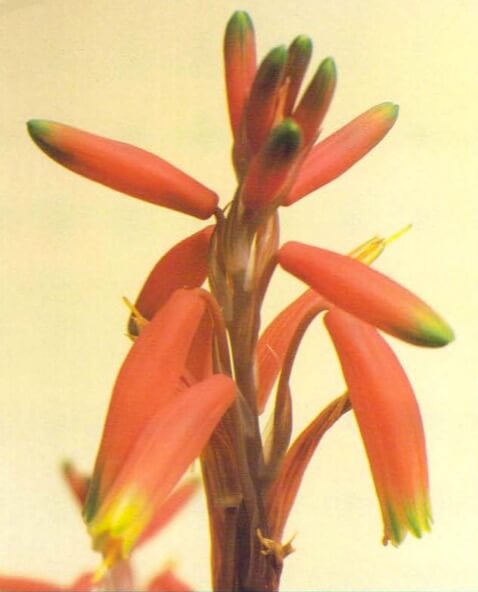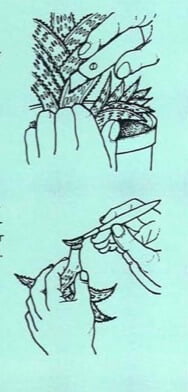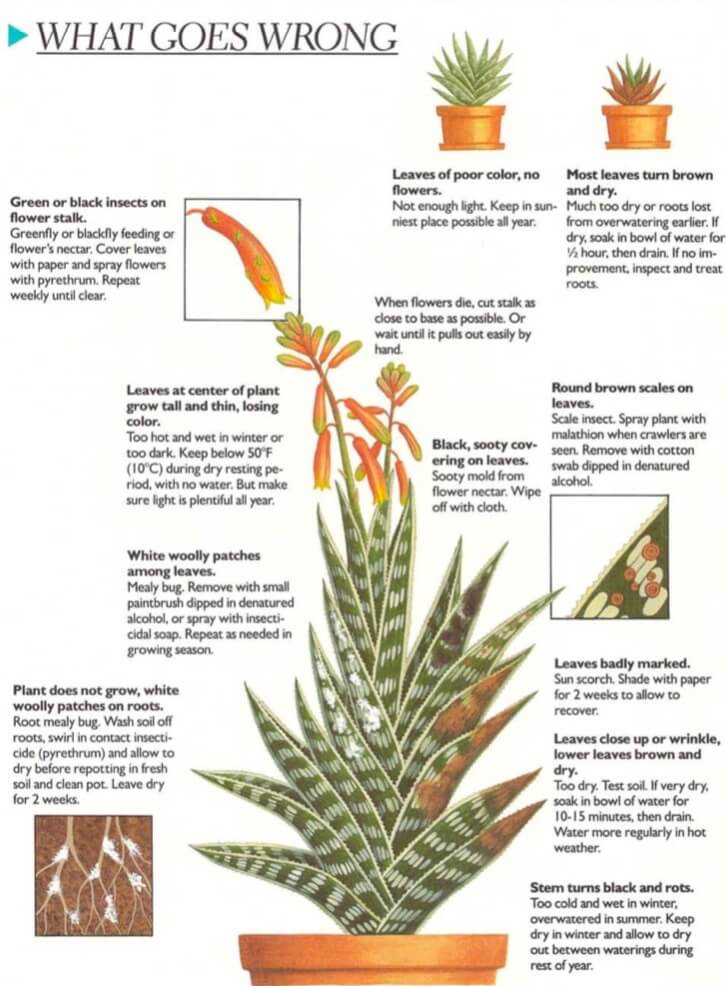[Ebook Việt Hoá] The Instant Guide to Healthy Houseplants (Hướng dẫn tức thời để chăm cây trong nhà khoẻ mạnh), Chi Aloe - Chi Lô Hội
[Ebook Việt Hoá] The Instant Guide to Healthy Houseplants: Aloe variegata (Tiger aloe)
- Nguồn: [Ebook Việt Hoá] The Instant Guide to Healthy Houseplants (Hướng dẫn tức thời để chăm cây trong nhà khoẻ mạnh)
- Biên tập: Dũng Cá Xinh
- Biên dịch: Team Codai.net
English
This large genus of plants originates from South Africa and parts of eastern Africa. Its species vary in size from large trees to tiny, hand sized plants. The smaller ones, very suitable for indoor or green house culture, are chose n primarily for the distinctive markings on their leaves. The red, yellow or pink flowers appear in winter or spring; they are tube shaped, and many are on a long stem like bluebells. Aloe variegata, which grows well on windowsills where it can take full advantage ofthe sunlight, will grow to about 1 foot (30 cm). Overwatering is the most common cause of failure. Other good species are A. albiflora, A. descoingsii, A. haworthiodes, A. parvula and A. somaliensis. The nonflowering A. vera is known as the “burn plant,” as its leaves contain sap that is said to heal burns and other skin inflammations.

Light
Maximum light is needed for best coloring and flower production.
Temperature
A minimum of 45°F (7°C) is safer for these plants, as many of them like a little water in the winter months. Give fresh air or stand outside in the summer, when no danger of frost threatens.
Water
Water just once a month in winter. Start watering more often in spring, building up to every week in summer; taper off again in autumn.
Feeding
Use a high-potash fertilizer once a month in summer; stop feeding in autumn.
Soil
Use good loam-based potting soil, with about 30 percent coarse, gritty sand to improve drainage.
Repotting
Every spring place in size-larger pot until in a 7- or 8-in (18- or 20-cm) size, when soil may be shaken off and plant repotted in fresh soil in same pot.
Propagation
Use offsets, which appear at soil level or low on the main stem.
Removing offsets
- 1. In spring or early summer, when offsets have 3-4 pairs of leaves, remove from parent plant with sharp knife.
- 2. Dust cut surfaces with hormone rooting powder to prevent infection, leave to dry for 2-3 days, then plant in dry soil.

What Goes Wrong

- Green or black insects on flower stalk: Greenfly or blackfly feeding or flower’s nectar. Cover leaves with paper and spray flowers with pyrethrum. Repeat weekly until clear.
- Leaves at center of plant grow tall and thin, losing color: Too hot and wet in winter or too dark. Keep below 50°F (10°C) during dry resting period, with no water. But make sure light is plentiful all year.
- White woolly patches among leaves: Mealy bug. Remove with small paintbrush dipped in denatured alcohol, or spray with insecticidal soap. Repeat as needed in growing season.
- Plant does not grow, white woolly patches on roots: Root mealy bug. Wash soil off roots, swirl in contact insecti- cide (pyrethrum) and allow to dry before repotting in fresh soil and clean pot. Leave dry for 2 weeks.
- Leaves of poor color, no flowers: Not enough light. Keep in sunniest place possible all year. When flowers die, cut stalk as close to base as possible. Or wait until it pulls out easily by hand.
- Black, sooty covering on leaves: Sooty mold from flower nectar. Wipe off with cloth.
- Most leaves turn brown and dry: Much too dry or roots lost from overwatering earlier. If dry, soak in bowl of water for 1/2 hour, then drain. If no improvement, inspect and treat roots.
- Round brown scales on leaves: Scale insect. Spray plant with malathion when crawlers are seen. Remove with cotton swab dipped in denatured alcohol.
- Leaves badly marked: Sun scorch. Shade with paper for 2 weeks to allow to recover.
- Leaves close up or wrinkle, lower leaves brown and dry: Too dry. Test soil. If very dry, soak in bowl of water for 10-15 minutes, then drain. Water more regularly in hot weather.
- Stem turns black and rots: Too cold and wet in winter, overwatered in summer. Keep dry in winter and allow to dry out between waterings during rest of year.
Tiếng Việt
Loài thực vật lớn này có nguồn gốc từ Nam Phi và các vùng phía đông châu Phi. Các loài của nó có kích thước khác nhau, từ những cây lớn đến những cây nhỏ bằng bàn tay. Những cây nhỏ hơn rất phù hợp khi trồng trong nhà hoặc nhà kính và chúng được chọn chủ yếu nhờ những nét đặc biệt trên lá. Những bông hoa màu đỏ, vàng hoặc hồng sẽ xuất hiện vào mùa đông hoặc mùa xuân; chúng có hình ống, và nhiều cây nằm trên một thân dài giống như quả tạ. Aloe variegata, phát triển tốt trên bệ cửa sổ – nơi có thể hấp thụ tối đa ánh sáng mặt trời, sẽ phát triển đến khoảng 1 foot (30 cm). Tưới nước quá mức là nguyên nhân phổ biến nhất gây chết cây. Các loài tốt khác là A. albiflora, A. descoingsii, A. haworthiodes, A. parvula và A. somaliensis. A. vera không ra hoa được gọi là “cây bỏng”, vì lá của nó chứa nhựa cây được cho là có thể chữa lành vết bỏng và các bệnh viêm da khác.

Ánh sáng
Cần ánh sáng tối đa để ra hoa có màu sắc đẹp nhất.
Nhiệt độ
Nhiệt độ tối thiểu 45 ° F (7 ° C) sẽ an toàn hơn cho những cây này, vì nhiều cây thích tưới ít nước vào những tháng mùa đông. Cung cấp không khí trong lành hoặc đặt ngoài trời vào mùa hè, khi thời tiết không có sương giá.
Nước
Chỉ tưới mỗi tháng một lần vào mùa đông. Bắt đầu tưới thường xuyên hơn vào mùa xuân, tăng cường độ hàng tuần vào mùa hè; giảm dần vào mùa thu.
Bón phân
Sử dụng phân bón có hàm lượng kali cao mỗi tháng một lần vào mùa hè; ngừng bón phân vào mùa thu.
Đất
Sử dụng đất bầu tốt làm từ mùn, với khoảng 30% cát sạn, thô để cải thiện hệ thống thoát nước.
Thay chậu
Mỗi mùa xuân thay vào chậu có kích thước lớn hơn cho đến chậu 7 – 8 inch (18 – 20 cm), khi đó rũ bỏ lớp đất bám trên rễ và trồng vào đất mới trong cùng một chậu.
Nhân giống
Sử dụng các chồi non, xuất hiện ở bề mặt đất hoặc phần cuối thân chính.
Loại bỏ các chồi non
- 1. Vào mùa xuân hoặc đầu mùa hè, khi cành nhánh có 3-4 cặp lá, dùng dao sắc loại bỏ khỏi cây gốc.
- 2. Rắc lên bề mặt lớp bột kích thích tố ra rễ để ngăn ngừa nhiễm trùng, để khô trong 2-3 ngày, sau đó trồng vào đất khô.

Những vấn đề có thể xảy ra

- Côn trùng màu xanh lá cây hoặc đen trên cuống hoa: Ruồi xanh và ruồi đen kiếm ăn hoặc tìm mật hoa. Che lá bằng giấy và phun pyrethrum lên hoa. Lặp lại hàng tuần cho đến khi sạch.
- Lá ở tâm cây mọc cao và mỏng, mất màu: Mùa đông quá nóng ẩm hoặc quá tối. Giữ dưới 50 ° F (10 ° C) trong thời gian nghỉ khô, không có nước. Nhưng hãy đảm bảo ánh sáng dồi dào quanh năm.
- Các mảng lông tơ trắng giữa các lá: Rệp sáp. Loại bỏ bằng cọ nhỏ nhúng trong cồn biến tính, hoặc phun xà phòng diệt côn trùng. Lặp lại khi cần thiết trong mùa sinh trưởng.
- Cây không phát triển, có những mảng lông trắng trên rễ: Rệp sáp rễ. Rửa sạch đất bám trên rễ, xới thuốc trừ sâu tiếp xúc (pyrethrum) và để khô trước khi thay vào đất mới và chậu sạch. Để khô trong 2 tuần.
- Lá nhạt màu, không có hoa: Không đủ ánh sáng. Giữ ở nơi nhiều nắng nhất quanh năm. Khi hoa tàn, cắt cuống càng gần gốc càng tốt. Hoặc đợi cho đến khi có thể ngắt dễ dàng bằng tay.
- Mốc đen trên lá: Mốc từ mật hoa. Lau sạch bằng vải.
- Hầu hết các lá chuyển sang màu nâu và khô: Quá khô hoặc mất rễ do tưới quá nhiều trước đó. Nếu khô, ngâm trong nước khoảng 1/2 giờ, sau đó để ráo. Nếu không cải thiện, kiểm tra và xử lý rễ.
- Vảy nâu tròn trên lá: Vảy côn trùng. Phun malathion cho cây khi nhìn thấy những con côn trùng. Loại bỏ bằng tăm bông nhúng vào cồn biến tính.
- Lá bị mốc: Cháy nắng. Che lá bằng giấy trong 2 tuần để nó phục hồi.
- Các lá trên nhăn lại, các lá phía dưới có màu nâu và khô: Quá khô. Kiểm tra đất. Nếu khô quá, ngâm trong nước khoảng 10-15 phút, sau đó để ráo. Tưới nước thường xuyên hơn khi trời nắng nóng.
- Thân cây chuyển sang màu đen và thối rữa: Mùa đông quá lạnh và ẩm ướt, mùa hè bị úng nước. Giữ khô ráo vào mùa đông và để khô ráo giữa các lần tưới trong thời gian còn lại của năm.
![[Ebook Việt Hoá] The Instant Guide to Healthy Houseplants: Aloe variegata (Tiger aloe) [Ebook Việt Hoá] The Instant Guide to Healthy Houseplants: Aloe variegata (Tiger aloe)](https://vn1.vdrive.vn/codai.net/2020/02/ebook-huong-dan-tuc-thoi-cham-cay-trong-nha-khoe-manh-119-aloe-variegata.jpg)


